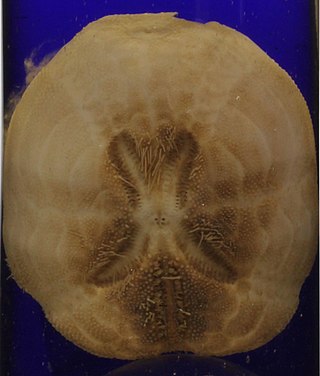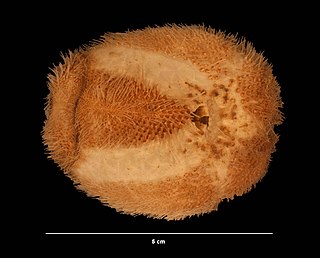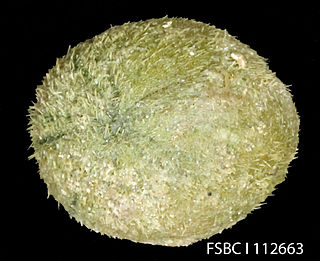
The Camarodonta are an order of globular sea urchins in the class Echinoidea. The fossil record shows that camarodonts have been in existence since the Lower Cretaceous.
Breynia desorii is a species of sea urchins of the family Loveniidae. Their armour is covered with spines. Breynia desorii was first scientifically described in 1851 by Gray.
Brissalius vannoordenburgi is a species of sea urchin in the Family Brissidae. Their armour is covered with spines. Brissalius vannoordenburgi was first scientifically described in 2008 by Coppard.

Brissopsis atlantica is a species of sea urchin of the family Brissidae. Their armour is covered with spines. Brissopsis atlantica was first scientifically described in 1907 by Ole Theodor Jensen Mortensen.

Brissopsis bengalensis is a species of sea urchins of the family Brissidae. Their armour is covered with spines. Brissopsis bengalensis was first scientifically described in 1914 by Koehler.
Brissopsis columbaris is a species of sea urchins of the family Brissidae. Their armour is covered with spines. Brissopsis columbaris was first scientifically described in 1898 by Alexander Emanuel Agassiz.

Brissopsis elongata is a species of sea urchins of the family Brissidae. Their armour is covered with spines. Brissopsis elongata was first scientifically described in 1907 by Ole Theodor Jensen Mortensen.

Brissopsis evanescens is a species of sea urchins of the family Brissidae. Their armour is covered with spines. Brissopsis evanescens was first scientifically described in 1950 by Ole Theodor Jensen Mortensen.

Brissopsis jarlii is a species of sea urchins of the family Brissidae. Their armour is covered with spines. Brissopsis jarlii was first scientifically described in 1951 by Ole Theodor Jensen Mortensen.

Brissopsis lyrifera is a species of sea urchins of the family Brissidae. Their armour is covered with spines. It was first described by the British naturalist Edward Forbes in 1841. This species of sea urchin is a nonselective, infaunal deposit feeder.
Brissopsis micropetala is a species of sea urchins of the family Brissidae. Their armour is covered with spines. Brissopsis micropetala was first scientifically described in 1948 by Ole Theodor Jensen Mortensen.

Brissopsis pacifica is a species of sea urchins of the family Brissidae. Their armour is covered with spines. Brissopsis pacifica was first scientifically described in 1898 by Alexander Emanuel Agassiz.

Brissopsis parallela is a species of sea urchins of the family Brissidae. Their armour is covered with spines. Brissopsis parallela was first scientifically described in 1914 by Koehler.
Brissopsis persica is a species of sea urchins of the Family Brissidae. Their armour is covered with spines. Brissopsis persica was first scientifically described in 1940 by Ole Theodor Jensen Mortensen.
Brissopsis similis is a species of sea urchins of the family Brissidae. Their armour is covered with spines. Brissopsis similis was first scientifically described in 1948 by Ole Theodor Jensen Mortensen.

Brissopsis zealandiae is a species of sea urchins of the family Brissidae. Their armour is covered with spines. Brissopsis zealandiae was first scientifically described in 1921 by Ole Theodor Jensen Mortensen.

Clypeaster australasiae, the Australasian sand dollar, is a species of sea urchins of the family Clypeasteridae. Their armour is covered with spines. Clypeaster australasiae was first scientifically described in 1851 by Gray.

Mellitidae is a family of sand dollars, in the echinoderm order Clypeasteroida. These irregular sea urchins bury themselves in soft sediment in shallow seas.
Schizasteridae is a family of echinoderms belonging to the order Spatangoida.

Brissopsis is a genus of echinoderms belonging to the family Brissidae.














